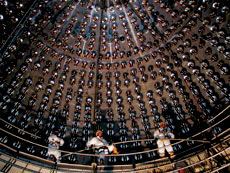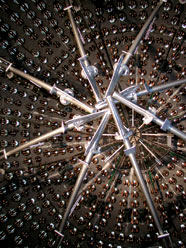   |
|
|
| |
|
|
|
|
 |
Aurelio Grillo |
|
INVESTIGATING THE ENERGY OF THE UNIVERSE:
THE GRAN SASSO NATIONAL LABORATORIES |
|
|
|
|
When we imagine
a large nuclear physics laboratory we might think of a place
where energy is produced, like in a nuclear power plant, or
of a place where more efficient ways of producing energy are
studied. Or even a place, like a large particle accelerator,
where elementary particles such as protons are brought to an
energy corresponding to that prevailing at the birth of the
Universe.
The Gran Sasso Laboratories are none of this. In the Laboratories
electrical power is used to run the electronic devices of
the experimental apparata. Energy is neither produced nor
converted into particles (with a small exception that we
will describe that later). |
 |
Inside
of the BOREXINO experiment sphere
Photo> PAOLO LOMBARDI INFN-MI/LNGS
|
| |
It is now
appropriate to give a very sketchy description of our
Universe.
From a merely anthropic point of view, the Universe can be
considered as a gigantic (in fact the biggest possible)
machine producing energy, or, better, converting
gravitational energy into all kinds of radiation, especially
light and heat (that are indispensable for life).
This description
of the Universe does not intend suggesting a causal
connection: this is only what man thinks the Universe
produces. It is fair to add, however, that even a Universe
slightly different from this would make antropomorphic life
very difficult. Let’s now take a snapshot of the Universe
when it was only a few hundred million years ‘old’ (its age
is now estimated to be approximately 14 billion years). At
that stage, the Universe contained matter (essentially
hydrogen and helium with traces of some heavier elements)
and possibly some form of exotic matter that nowadays is
called ‘dark’.
|
There was also very little
light: stars had not yet formed
This ‘almost’ is extremely
important: if the gas filling the Universe had been
completely uniform, it would have been extremely difficult
for the present Universe to emerge. Being matter
distribution not exactly uniform, gravitational force was
stronger where matter concentrated. These concentrations of
matter attracted more matter, that generated more gravity…
and so on until “structures”, (that is Galaxies and stars),
were formed. Matter was no longer uniformly distributed but
in clumps, more or less like in the present Universe.
 |
 |
|
Inside of the BOREXINO
experiment sphere
Photo> PAOLO LOMBARDI
INFN-MI/LNGS |
|